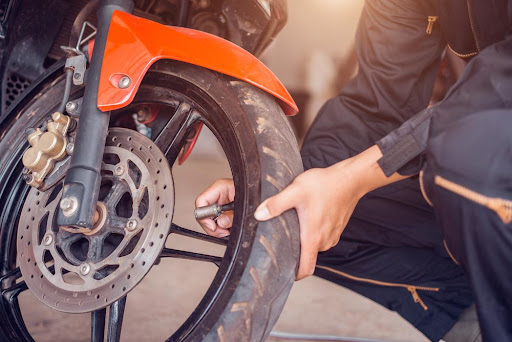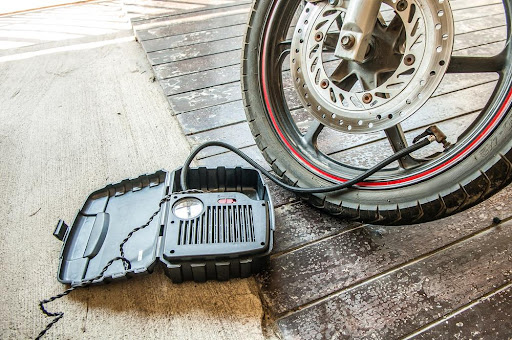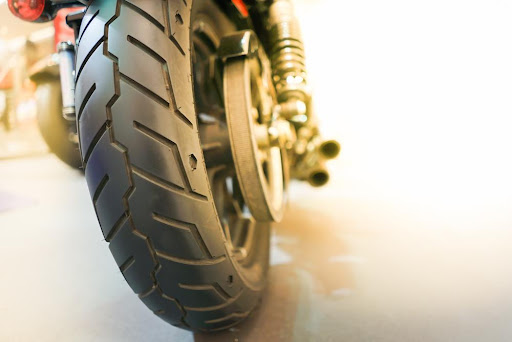The air inside your motorcycle tires does a lot of heavy lifting. In fact, it supports the entire weight of your motorcycle, which can be several hundred pounds or more. The air also provides traction and protects your wheels from wear and tear. Setting the right tire pressure depends on riding conditions and your specific make and model. Over or under-inflating your tires can lead to problems behind the wheel, including poor handling, decreased fuel efficiency, and less comfort as you start to feel the bumps in the road. Checking and adjusting your tire pressure will help you stay safe regardless of where you like to ride. Use this guide to calculate exactly how much air your tires need with Motorcycle Tire Pressure.
Why is Tire Pressure Important?
Every driver knows that tire pressure is an essential part of vehicle maintenance. Most vehicles use pneumatic tires that are filled with air. The air is stored inside what’s known as the carcass, protected by several layers of high-density fibers, usually polyester, aramid, or steel. The carcass is then coated in wear-resistant rubber that rolls along whatever surface the motorcycle is driving on. The tire has a unique tread pattern that provides traction with the road while pushing debris to the side.
Tires need to flex when interacting with a surface. Rubber generates heat when it flexes, which leads to wear and tear. The air flexes instead, which provides a buffer for the rubber. Your tires will flatten when they meet the surface as the air changes shape to adjust the contact area.
The amount of air inside your tires affects its ability to change shape. The less air inside your tires, the larger the contact area, and vice versa. Increasing tire pressure will decrease the surface area by keeping the tires rigid, which also preserves the rubber.

The air also carries the weight of your motorcycle. You can calculate the exact contact area by dividing the total weight of your bike, including you and your cargo, by the tire’s inflation pressure. If the load weights 200 lbs. and your tires are inflated to 40 pressure per square inch (PSI), the footprint would be approximately 5 square inches. You can adjust the tire pressure accordingly based on how much your tires need to interact with the underlying surface.
Finding the Right Tire Pressure for Your Motorcycle
If you’re trying to figure out how much air your tires need, there are several factors to consider, including your speed, vehicle weight, surface temperature of the road, and driving conditions.
Every tire and motorcycle make and model comes with its own pressure recommendations. Manufacturers put their products through extensive testing to determine the proper air pressure level to improve performance.
If you are driving your motorcycle on the highway or street, it’s best to refer to the manufacturer’s original recommendations. You can find the tire pressure specifications on the placard applied to the motorcycle frame as or in your vehicle owner’s manual. Let’s say you need to pump up your tires, but you don’t have access to either. You can use Bluetooth motorcycle helmet speakers to find the information you need. The speakers are wirelessly connected to your phone, so you can quickly search the web or contact a loved one without taking your eyes off the road.
Heavier motorcycles tend to have higher inflation recommendations. The extra air makes up for the added weight, so the contact area remains constant. The same is true if you add extra weight to your motorcycle. If you are adding a cargo pack, tail pack, or another passenger, consider increasing your PSI by a point or two. Lighter motorcycles, including motocross bikes, street racers, and commuter bikes, require less air pressure.
The temperature can also affect your tire pressure. In general, tires usually lose or gain 1 PSI for every 10℉ change in temperature. Heat increases pressure while the cold decreases pressure. Consider under or over-inflating your tires by a few points during the winter and summer.
If you plan on driving off road, it’s best to go down a few PSI to increase traction in the mud, dirt, snow. Taking a little air out of your tires increases flexibility and the contact area, giving your tires more room to get a grip. The same is true when driving in the rain snow.
When inflating your tires, you should never exceed the manufacturer’s original PSI recommendations even if you are carrying a heavy load. Overinflating reduces traction and can be dangerous.

Testing and Adjusting Air Pressure
It’s best to check your tire pressure before every trip, but your tire pressure gauge might not be accurate. Experts say cheap gauges that are made of plastic tend to be off by 5 to 8 PSI, while metal gauges tend to be more accurate.
You may want to check the pressure continuously throughout the day as the temperature changes. Keep a pump handy in case you need to adjust your air pressure along the way. If you don’t have a pump, use your motorcycle Bluetooth headset to find the nearest auto shop in your area without taking your eyes off the road.
A few pounds per square inch can make all the difference in the world. Use helmet communication to stay safe every time you hop on your bike. You can call for help in an emergency without reaching for your phone. It’s always better to be safe than sorry.



